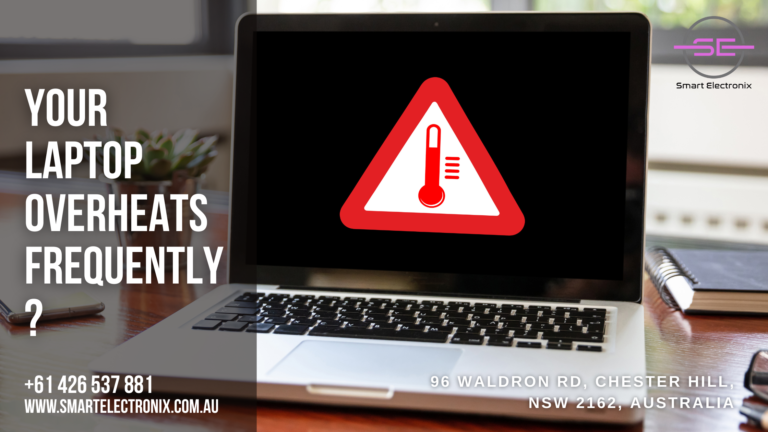
It usually starts with a warm lap, then the fan kicks in like a jet engine, and suddenly your laptop slows down or even shuts off. Sound familiar? If your device is regularly overheating, you’re not alone. At Smart Electronix, we know how frustrating this issue can be—especially when you’re working, gaming, or just browsing.
Laptop overheating is one of the most common tech problems in 2025. But the good news? There are several simple fixes and preventative measures you can take. In this guide, we’ll walk you through practical solutions to cool things down and keep your device running smoothly.
Why Does Your Laptop Overheat?
Before diving into solutions, it helps to understand the causes:
- Poor ventilation: Dust buildup or blocked air vents can trap heat.
- Heavy usage: Running demanding software or multiple apps.
- Aging thermal paste: This compound between your CPU/GPU and heat sink dries out over time.
- Battery stress: Old or faulty batteries can cause excess heat.
- Ambient temperature: Hot environments make it harder to dissipate heat.
Step-by-Step Guide to Fix Overheating Laptops
1. Clean Out Dust and Debris
Over time, dust collects inside your laptop, blocking fans and vents. Here’s how to fix that:
- Power down and unplug your device.
- Use compressed air to blow out dust from vents.
- Open the laptop (if you’re comfortable) and clean internal fans gently.
At Smart Electronix, we offer professional cleaning services for delicate internal parts.
2. Use a Cooling Pad
An external cooling pad helps reduce heat by improving airflow:
- Choose one with high-speed fans.
- Use it on a hard surface, not your bed or couch.
- This can lower internal temperatures by several degrees.
It’s one of the easiest upgrades you can make for heat management.
3. Update Your Software and Drivers

Sometimes overheating is due to software inefficiencies:
- Update your operating system and all drivers.
- Check for firmware updates on the manufacturer’s website.
- Ensure background apps aren’t running unnecessarily.
This keeps your system optimized and less likely to overwork its hardware.
4. Adjust Power Settings
Your power settings play a big role in system performance and heat:
- Go to Control Panel > Power Options.
- Select “Balanced” or “Power Saver” mode.
- Limit CPU maximum performance to reduce heat output.
Reducing power consumption can drastically help in minimizing temperature spikes.
5. Replace Thermal Paste
Thermal paste transfers heat from your processor to the heat sink:
- Over time, it dries out and becomes less effective.
- Applying a fresh layer requires opening your laptop and carefully cleaning old residue.
- Use high-quality thermal compound for best results.
If you’re unsure, Smart Electronix offers thermal paste replacement services by experienced technicians.
6. Elevate the Laptop
Improving airflow underneath your device can make a big difference:
- Use a laptop stand or prop the back with small items.
- Keep vents unobstructed by objects or soft surfaces.
This helps air circulate more efficiently and reduces internal heat buildup.
7. Monitor Your Laptop’s Temperature
Install temperature monitoring tools:
- Apps like HWMonitor or Core Temp give real-time data.
- If temperatures exceed 90°C regularly, action is needed.
Knowing the actual heat levels helps you take timely preventive steps.
8. Limit Intensive Tasks
If your laptop runs hot during gaming or video editing:
- Close unnecessary applications.
- Use task manager to check CPU usage.
- Reduce screen brightness and disconnect peripherals.
Smart performance management goes a long way in controlling heat.
9. Scan for Malware
Viruses and malware can cause system overload:
- Use trusted antivirus software.
- Run full scans regularly.
- Remove suspicious programs that spike CPU usage.
A cleaner system = a cooler system.
10. Consider an Upgrade
Sometimes, older laptops simply can’t keep up:
- Upgrading RAM or SSD can reduce workload on the processor.
- Consider investing in a newer model with better cooling design.
At Smart Electronix, we offer a wide range of high-performance laptops and accessories designed for efficiency and heat control.
When to Visit a Professional

If your device still overheats after all these fixes, there might be deeper hardware issues:
- Damaged fan or internal components.
- Motherboard failure.
- Faulty sensors or battery cells.
Don’t try to repair critical parts unless you’re confident. Bring it in to Smart Electronix and let our certified technicians handle it safely and professionally.
Final Thoughts
Overheating is a serious issue, but not an unsolvable one. With consistent care, timely updates, and a few simple tools, you can extend your laptop’s life and performance. And remember—for expert advice, parts, or repairs, Smart Electronix has your back.
Visit Smart Electronix for more tips, tech solutions, and premium-quality smart electronics designed to meet your daily digital needs.
